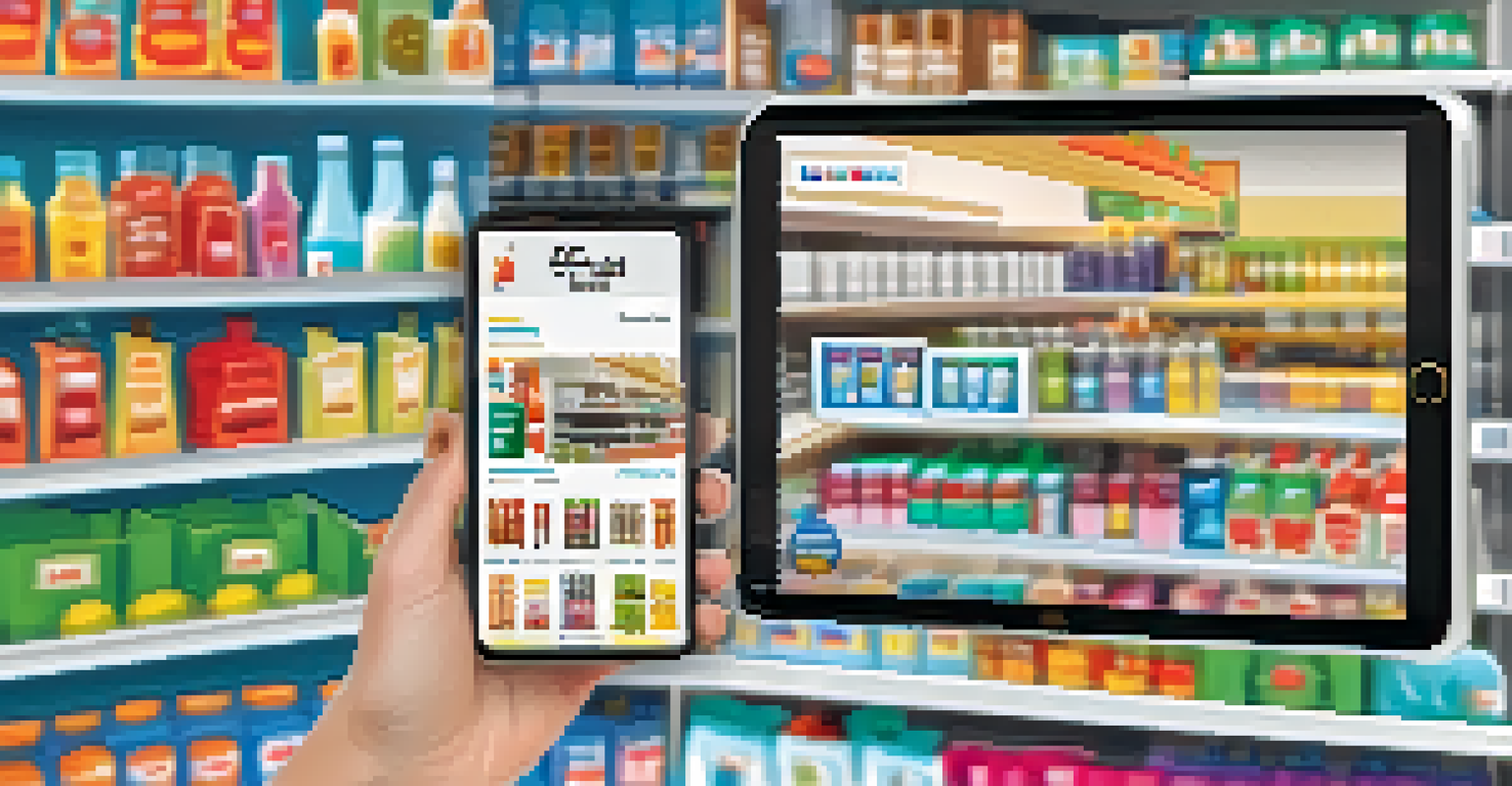Exploring Augmented Reality in Retail: Transforming Shopping

What is Augmented Reality and Its Role in Retail?
Augmented Reality (AR) blends digital content with the real world, creating immersive experiences for users. In retail, this technology enhances the shopping journey by allowing customers to visualize products in their environment before making a purchase. Think of it as a virtual fitting room or a product demo right in your living room.
Augmented reality will change the way we shop, allowing consumers to see products in their own environment before making a purchase.
By using AR applications on smartphones or AR glasses, shoppers can see how furniture fits in their homes or how a new pair of shoes looks on their feet without ever stepping foot in a store. This not only improves customer engagement but also helps reduce return rates, as buyers are more confident in their choices.
As retailers embrace AR, they are setting themselves apart in a competitive market. This technology not only captures consumer interest but also fosters a deeper connection between brands and customers, making the shopping experience more interactive and enjoyable.
Enhancing Customer Engagement with Interactive Experiences
One of the most exciting aspects of AR in retail is its ability to engage customers in unique ways. Brands are creating interactive experiences that not only showcase products but also tell a story. Imagine walking into a store and scanning a product with your phone, instantly unlocking a video that shows how it’s made or how to use it effectively.

This level of engagement keeps customers interested and encourages them to explore the store further. By turning shopping into an adventure, retailers can create memorable experiences that resonate with consumers long after they’ve left the store.
AR Enhances Retail Experiences
Augmented Reality allows customers to visualize products in their environment, improving engagement and reducing return rates.
Moreover, these interactive elements can drive social sharing, as customers are likely to share their experiences on social media. This organic promotion can significantly enhance brand visibility, drawing in new customers who are intrigued by the innovative shopping experience.
Personalization: Tailoring the Shopping Experience
Personalization is a key trend in retail, and AR takes this to the next level. With the help of AR, retailers can offer tailored shopping experiences based on individual customer preferences and behaviors. For instance, a customer might receive personalized product recommendations after scanning a QR code in-store.
The future of retail lies in personalization, and augmented reality offers the tools to create bespoke shopping experiences.
This technology can analyze past purchases, browsing habits, and even social media interactions to suggest items that align with a shopper's tastes. This level of customization not only enhances the shopping experience but also builds brand loyalty, as customers feel understood and valued.
Ultimately, AR-enabled personalization transforms a one-size-fits-all approach into a bespoke shopping journey. Retailers who harness this capability can create stronger relationships with their customers, leading to increased satisfaction and repeat business.
AR in E-commerce: Bridging the Physical and Digital Worlds
While physical retail is embracing AR, e-commerce is not far behind. Online retailers are integrating augmented reality features to help customers visualize products in their own spaces before purchasing. For example, furniture companies allow customers to use AR to see how a sofa would look in their living room, effectively bridging the gap between online and offline shopping.
This capability helps mitigate one of the biggest challenges of online shopping: the inability to see and feel products before buying. With AR, shoppers can make more informed decisions, leading to higher conversion rates and reduced returns.
Personalization Drives Loyalty
AR technology enables retailers to provide tailored shopping experiences, fostering stronger customer relationships and brand loyalty.
As e-commerce continues to grow, the incorporation of AR will become essential for retailers looking to differentiate themselves and enhance the online shopping experience. By providing a seamless blend of the digital and physical worlds, retailers can create a more compelling reason for consumers to shop online.
Challenges and Limitations of Augmented Reality in Retail
Despite its potential, AR in retail does face challenges. One major hurdle is the need for customers to own compatible devices, such as smartphones or AR glasses. Not all consumers are equipped or willing to engage with this technology, which can limit its reach.
Moreover, the development and implementation of AR applications can be resource-intensive for retailers. Brands must invest in technology and training to ensure their staff can effectively use and promote AR tools, which may deter some smaller retailers from adopting it.
Additionally, there's always the risk that technology may not work flawlessly, leading to frustration for customers. Retailers must continuously refine their AR applications to ensure a smooth, engaging experience that meets consumer expectations.
Future Trends: The Next Frontier of AR in Retail
As technology evolves, the future of AR in retail looks promising. Experts predict that we will see even more sophisticated applications, such as AR-enhanced virtual reality experiences that allow customers to experience products in simulated environments. Imagine trying out a vacation destination virtually before booking your trip!
Furthermore, advancements in artificial intelligence may lead to more intuitive AR experiences. For instance, AR applications could learn from user interactions to improve product recommendations and personalize the shopping journey even further.
E-commerce Benefits from AR
Online retailers are adopting AR features to help customers visualize products, bridging the gap between digital and physical shopping.
With these innovations on the horizon, the retail landscape is poised for transformation. Retailers who embrace these trends will not only improve customer satisfaction but also position themselves as leaders in the ever-evolving retail sector.
Success Stories: Brands Leading the AR Revolution
Several brands have successfully integrated AR into their retail strategies, showcasing the technology's potential. For instance, IKEA's AR app allows users to visualize how furniture would look in their homes, making it easier to choose the right pieces without the hassle of returns.
Similarly, cosmetics brands like Sephora have developed AR features that let customers virtually try on makeup before purchasing. This not only enhances the buying experience but also reduces the likelihood of buyers remorse.

These success stories highlight how AR can create meaningful connections between brands and consumers. By investing in innovative technology, retailers can enhance their offerings and stand out in a crowded marketplace.